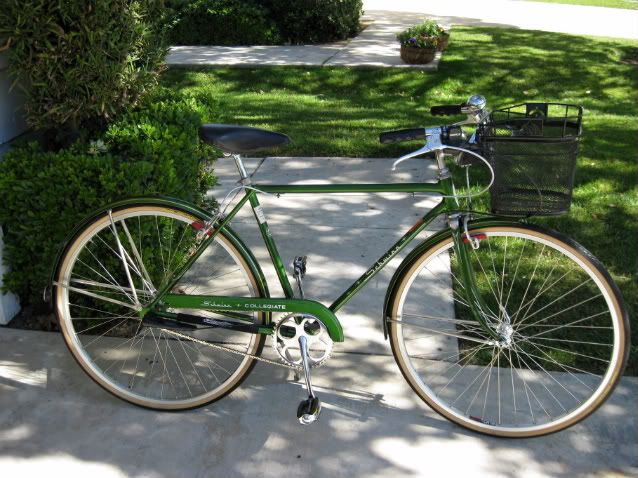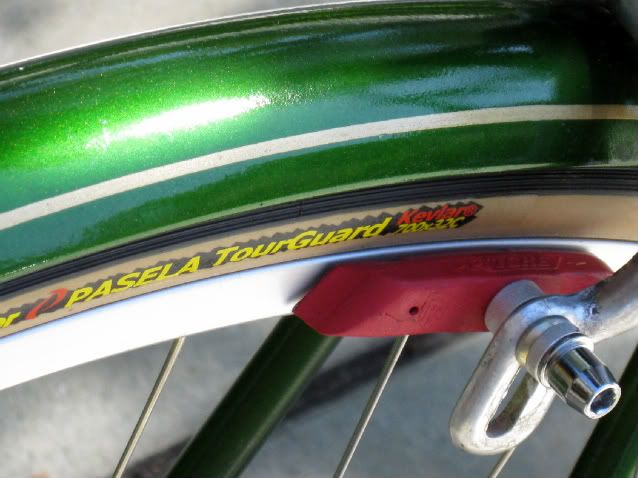How many of you rattle can your bikes? How is the outcome? worth wet sanding respraying or dose on coat make it nice and smooth? Pictures? and Also dose anyone know if HOK stopped making their rattle can paint? I seen it at the hobby store a while back but went to check out something else recently and it was gone, nothing on the site.
You are using an out of date browser. It may not display this or other websites correctly.
You should upgrade or use an alternative browser.
You should upgrade or use an alternative browser.
Rattle Can paint
- Thread starter Pawel
- Start date

Help Support Rat Rod Bikes Bicycle Forum:
This site may earn a commission from merchant affiliate
links, including eBay, Amazon, and others.
Hey Pawel, seeing as I don't own a compressor, it's all rattle-can here 
Ultimately, it's all about what you want to get out of it. If you want a show quality, trophy winning, knock-em dead paint job, then by all means spray sand repeat, follow with many coats of clear sanding between each.
If the parts already have a decent factory finish, just a quick scuff to give your new color some tooth should do. Thats what I did here.

And this is how it turned out;

All rattle can, and testors model paint straight out the jar;

Sorry man, can't seem to find any info about HOK aerosols anywhere on their site.
Rick
Ultimately, it's all about what you want to get out of it. If you want a show quality, trophy winning, knock-em dead paint job, then by all means spray sand repeat, follow with many coats of clear sanding between each.
If the parts already have a decent factory finish, just a quick scuff to give your new color some tooth should do. Thats what I did here.

And this is how it turned out;

All rattle can, and testors model paint straight out the jar;

Sorry man, can't seem to find any info about HOK aerosols anywhere on their site.
Rick
my rattle can below: Depending how you want the outcome... etching primer, base primer, rattle can paint, clear coat. Each coat MULTIPLE times and in between coats you wet sand increasing to finer grit each time you sand. Eventually ending up with 2000 grit wet sanding last coat of paint


I don't put a whole lot of effort into it. Hmmm kinda like my life in general :lol:
Bare metal I etch primer if II happen to have it, then several coats of color and several coats of clear. I don't know that I've ever sanded between coats. I figure the more effort and time I put in to it the more likely it'll get damaged.
Don't know that they come out all that smooth but hey if you're riding it no one will be able to touch it anyway
Here's a few I've rattle canned...



Bare metal I etch primer if II happen to have it, then several coats of color and several coats of clear. I don't know that I've ever sanded between coats. I figure the more effort and time I put in to it the more likely it'll get damaged.
Don't know that they come out all that smooth but hey if you're riding it no one will be able to touch it anyway
Here's a few I've rattle canned...



yeah, you used to be able to get small (maybe 6oz) cans of HOK and codington custom paint in hobby shops and the model car section at wal*mart. i havent looked in a while. i'd say try wally world.
they dont advertise it, but car quest auto parts carries it. it's kinda pricey, the color selection is weak, and it need to be speacial ordered. if there's one in yer town check there.
they dont advertise it, but car quest auto parts carries it. it's kinda pricey, the color selection is weak, and it need to be speacial ordered. if there's one in yer town check there.
I spray paint all my bikes and if your take the time it will end up nice. Sand or media blasting is also good to remove the old paint but it leaves the metal rough so you have to sand it down to make it smoother.
I rattle can per instructions using all the cool Rustoleum/Krylon colors. Many very light coats is fairly rapid succession. And then use mega-will power to leave it alone for a very long time (days) before assembling. That's the hardest part. :wink:
I rattlecan almost all of my bike builds, including most of my old school bmx restorations. It's not too hard to get a really nice finish out of spray paint- the most important thing I've learned is that your paint job is only as good as your primer job. Take the time to prep the parts and put on a nice smooth primer job and the paint will look 10 times better.
I'll lay on a primer coat and let it dry, then hit it with Scotchbrite before the next coat of primer. If you don't scuff the primer it dries with a slight texture, and whatever paint you shoot on there will take on that same texture- thereby requiring tons more coats to make it smooth and glossy. It's a lot easier to Scotchbrite primer than it is to wetsand and polish paint.
"And then use mega-will power to leave it alone for a very long time (days) before assembling. That's the hardest part. "
So, so, so true! :mrgreen:
I'll lay on a primer coat and let it dry, then hit it with Scotchbrite before the next coat of primer. If you don't scuff the primer it dries with a slight texture, and whatever paint you shoot on there will take on that same texture- thereby requiring tons more coats to make it smooth and glossy. It's a lot easier to Scotchbrite primer than it is to wetsand and polish paint.
"And then use mega-will power to leave it alone for a very long time (days) before assembling. That's the hardest part. "
So, so, so true! :mrgreen:
all those look great guys. I just gotta figure out whats the deal with the HOK they had the candies in the smaller cans and Im sure I could make something with those work down the road, I was just curious whats up with Rattle Can 
I USED to do shiney (prep and prep and prep). But every time I got a scratch or a nick (you're gonna get them), I would say, "You rotten #$#@%^&$*" so now I just do flat with a satin or FLAT gloss clear coat. I just like simple, neat and clean now.
it is all prep. also keep in mind no matter how well you do it rattle can will scratch much easier than other forms of painting. but some like the paint i used on the higgins is quite durable. that bike has fallen over more than a few times
I'm not talented at anything but I have experience in a lot of stuff. Rattle can painting is one of those things in which I'm no expert but I can share what I do know from experience. Any kind of painting to achieve a high gloss is tricky. You can fan a light coat on it and stop and you will more than likely have dull dry spots in it. High gloss comes from spraying enough paint (and you must use a good grade of paint) to get the high gloss you want without spraying so much that you get a run which is what you don't want. It's tricky and you will make mistakes trying to gain enough experience to achieve this. I don't like talking about my mitakes but if I did we would have about 600 pages.
Here are photos of the frame of Toothless Jack that I painted yesterday with Rust-o-leum Orange. Thankfully I got gloss and no runs (even surprise myself sometimes). Of course tubing is always hard for me to paint, trying to get an even amount of paint on all 4 sides. Oh, and dont worry about trying to cover all the primer with the first coat (mistake # 1). I usually do at least 3 heavy coats because it may look great when the spraying is finished but all paints shrinks as it dries. If you don't put enough coats, as it shrinks you will see many of the frames defects and chips and scratches in the old paint or primer that you just covered. Don't take this as me being arragant because I'm not that way and I don't know a lot, but I know what I know.
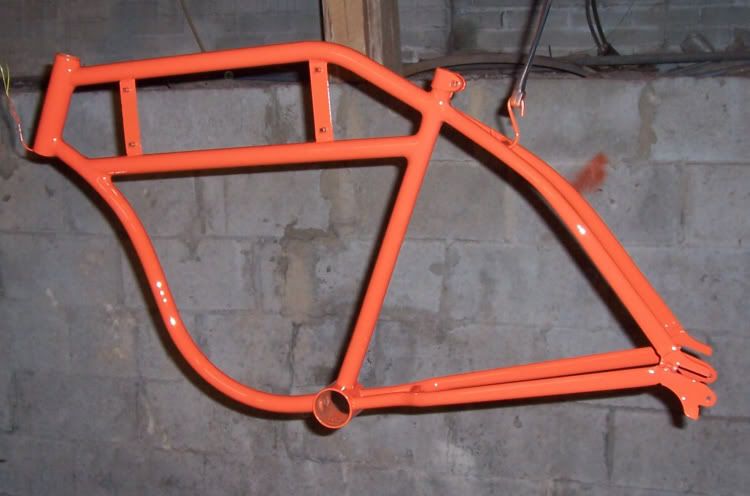
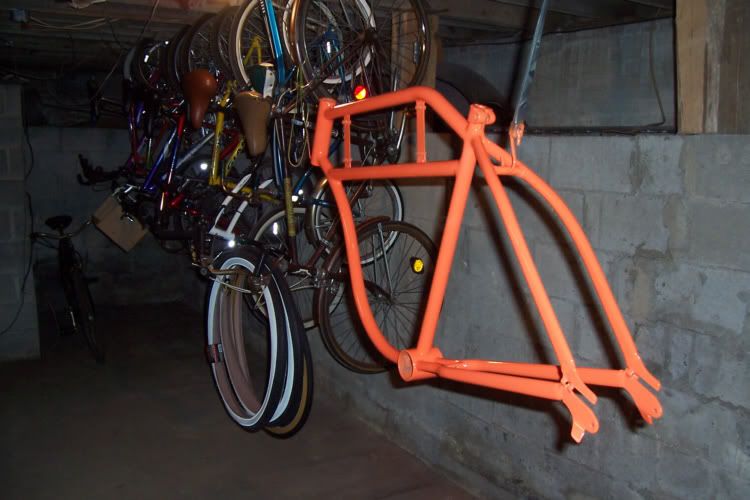
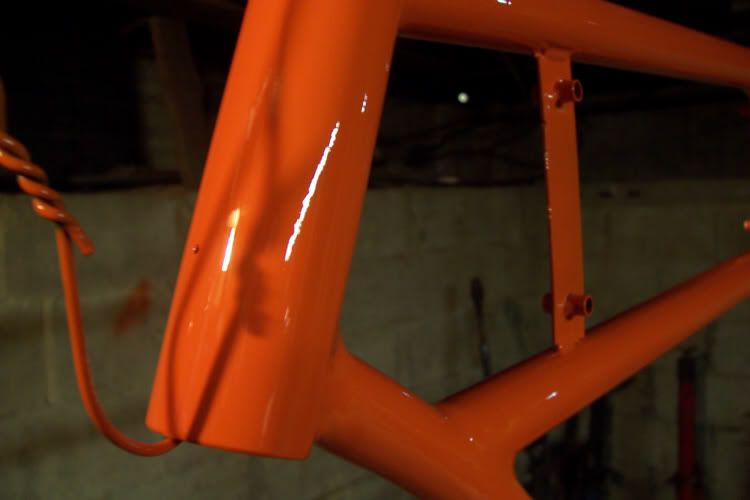
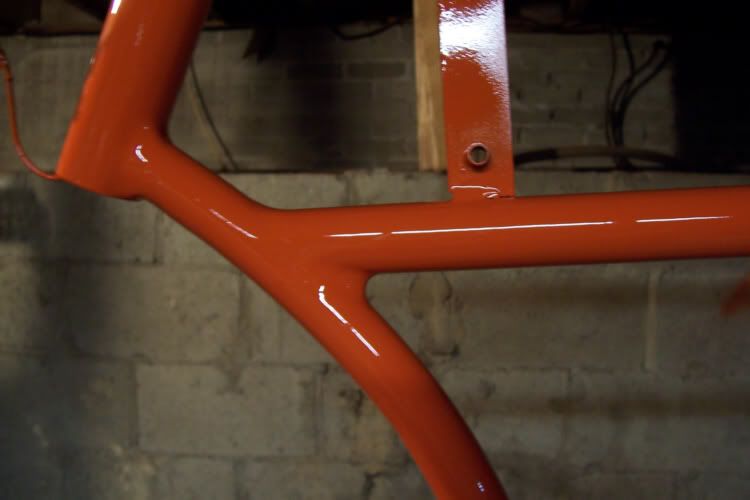
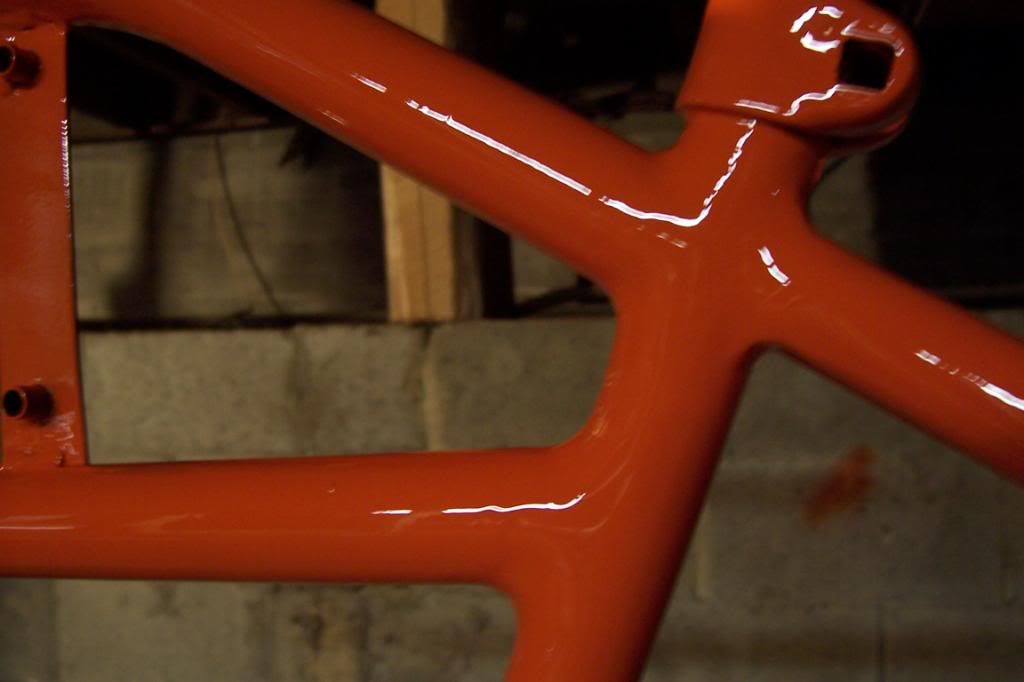
I hope this will help somebody.
Here are photos of the frame of Toothless Jack that I painted yesterday with Rust-o-leum Orange. Thankfully I got gloss and no runs (even surprise myself sometimes). Of course tubing is always hard for me to paint, trying to get an even amount of paint on all 4 sides. Oh, and dont worry about trying to cover all the primer with the first coat (mistake # 1). I usually do at least 3 heavy coats because it may look great when the spraying is finished but all paints shrinks as it dries. If you don't put enough coats, as it shrinks you will see many of the frames defects and chips and scratches in the old paint or primer that you just covered. Don't take this as me being arragant because I'm not that way and I don't know a lot, but I know what I know.





I hope this will help somebody.
i believe painting anything requires the same respect. if you take the time to do it right, you'll get the results you were looking for. that applies for painting bike frames, helmets, walls in your house, and even graffiti.
when you rush through a paint job, it shows. i tell everyone, "just take your time, and be prepared to do it all over again"
iv'e painted with pneumatic equipment, and air brushes, but i love the ease of the can.
i think paint in a spray can is the best invention since luggage with wheels :lol: and nothing screams RAT! like a spray-painted bike..... 8)
when you rush through a paint job, it shows. i tell everyone, "just take your time, and be prepared to do it all over again"
iv'e painted with pneumatic equipment, and air brushes, but i love the ease of the can.
i think paint in a spray can is the best invention since luggage with wheels :lol: and nothing screams RAT! like a spray-painted bike..... 8)
I've had good luck using Krylon. Prep is the most important. When I worked in the machine shop I had access to a kick@$$ bead blaster with an industrial compressor that put out a constant 100psi and never blinked. I'd blast them to bare metal with beads (NOT sand) and immediately prime them right out of the cabinet without touching them with bare hands. I use lots of primer. My paint stays put and don't flake off. Several light coats until covered well, then the last coat heavier exactly like rgallen described. All brands of paint go on a bit differently so master one brand before you move to another type of paint. Patience grasshopper! B607


As far as durability is concerned, I have found spray bombs to be decent, but again, it is all about prep. I had a Rocky Mountain (mountain bike) that I repainted, I sanded the original powder coat (I found that removing powder coat completely is more trouble than it's worth) used DP-40 primer out of a gun, but my finish coat was Rust-Oleum white enamel from a can. That bike endo'd and bounced down the trail without me more than a few times... and the paint held up great.
On the other hand, my first lowrider I built, my dad painted it for me with DP-40 primer, and R-M base/clear, all out of the gun... that was an awesome (shiny) paint job, but it chipped just from looking at it wrong.
I think the thing with rust paints is that they always stay a little soft, which resists chipping. Good for something that gets knocked around a bit like a bike.
On the other hand, my first lowrider I built, my dad painted it for me with DP-40 primer, and R-M base/clear, all out of the gun... that was an awesome (shiny) paint job, but it chipped just from looking at it wrong.
I think the thing with rust paints is that they always stay a little soft, which resists chipping. Good for something that gets knocked around a bit like a bike.




